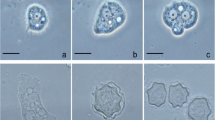Abstract
Species-level identification of Acanthamoeba isolates is difficult and gives little or no indication of the isolate's pathogenicity. We identified two amplification-based genetic markers that were highly correlated with pathogenicity in Acanthamoeba spp. One marker, designed to amplify a 485-bp fragment of the small-subunit ribosomal RNA gene (ssrDNA), was preferentially amplified from the nonpathogenic strains; amplifications from the pathogenic strains yielded anomalous fragments of 650 and 900 bp. A second marker was developed on the basis of the anomalous 650-bp fragment. Primers to this sequence preferentially amplified a noncoding locus (called Ac6) only from the pathogenic strains. These two genetic markers may be useful for identification of pathogenic Acanthamoeba spp. strains.
Similar content being viewed by others
Author information
Authors and Affiliations
Additional information
Received: 29 July 1996 / Accepted: 5 November 1996
Rights and permissions
About this article
Cite this article
Howe, D., Vodkin, M., Novak, R. et al. Identification of two genetic markers that distinguish pathogenic and nonpathogenic strains of Acanthamoeba spp.. Parasitol Res 83, 345–348 (1997). https://doi.org/10.1007/s004360050259
Issue Date:
DOI: https://doi.org/10.1007/s004360050259




